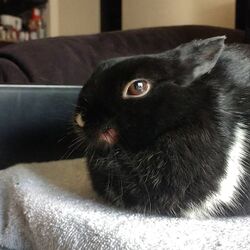Ringworm
Species that can cause ringworm, also known as dermatophytosis, on rabbits include Microsporum canis, Microsporum gypseum, Microsporum audouinii, Trichophyton mentagrophytes, Trichophyton verrucosum and Trichophyton schoenleinii. Trichophyton mentagrophytes is more commonly seen in laboratory and outdoor rabbits while M. canis is more usually seen in pet and house rabbits.[1]
Ringworm is most commonly seen on young rabbits, especially where husbandry is suboptimal, in addition to any underlying medical conditions which may strain the rabbit's immune system. It is uncommon in rabbits, but ringworm can be zoonotic, and asymptotic infections have been reported with humans.[1]:250
Symptoms

- circular and crusty areas with fur loss (alopecia) and redness (erythema). These areas are usually found on areas that are frequently groomed, like the base of the ears and muzzle, but can spread to other parts of the body.[1]:298
Causes
Ringworm has been associated with underlying stressors such as concurrent disease, poor nutrition, or experimental manipulation.[1]:299
Treatment
Ringworm can be treated with giseofulvin orally or topical miconazole, clotrimazole or enilconazole.[1]:299
Concurrent administration with cisapride should be avoided, as there is potential for adverse drug interactions to occur.[1]:299
Experiences
- Wick & Fable. (2017). (Update!) Fungal/Ringworm Tx (no actual worms involved)
Further reading
- Frances Harcourt-Brown, Ringworm
- PetEducation.com, Ringworm in Rabbits and Guinea Pigs: Transmission, Signs, Diagnosis, Treatment
- MediRabbit.com, Fungal Dermatitis or Superficial Mycosis
- The Bunny Hut, Ringworm in Rabbits. (2016).
- Vetstream, Ringworm

